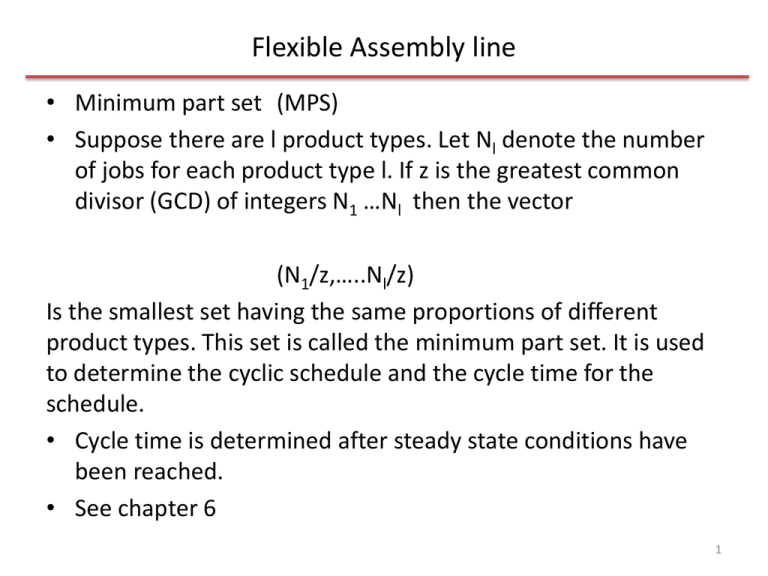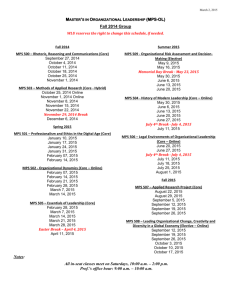notes 6
advertisement

Flexible Assembly line • Minimum part set (MPS) • Suppose there are l product types. Let Nl denote the number of jobs for each product type l. If z is the greatest common divisor (GCD) of integers N1 …Nl then the vector (N1/z,…..Nl/z) Is the smallest set having the same proportions of different product types. This set is called the minimum part set. It is used to determine the cyclic schedule and the cycle time for the schedule. • Cycle time is determined after steady state conditions have been reached. • See chapter 6 1 Unpaced Flexible Assembly line • Consider a number of machines in series with a limited buffer between them • The material handling system that moved the product from one to the next machine is unpaced • Bypass is not allowed • A machine can release its product to the next only if there is space in the buffer otherwise it is blocked • Machines serve jobs in a first-in-first-out FIFO system. • Ex: Assembly of televisions or copiers • The buffer space is viewed as a machine with no processing time. – So a system with buffers is transformed into a system with no buffers, which make it easy to solve. 2 Unpaced Flexible Assembly line • Profile fitting heuristics • Select a job with the largest total processing time as the first job in the MPS • For all the remaining jobs, consider each one of them- one at a time - and schedule it as the next job • Calculate the total nonproductive time on all the machines • Select the job with the lowest total nonproductive time as the next job in the partial sequence • Stop when all the jobs in the MPS have been scheduled • Weighted Profile fitting heuristics – A weight is given to the nonproductive time on each machine 3 Unpaced Flexible Assembly line Jobs P1j P2j P3j 1 2 4 2 2 4 4 0 3 2 0 2 4 3 2 0 Weights on nonproductive time machine 1 and 2 = 2 Machine 3 = 1 4 Paced Flexible Assembly line • Paced lines have a conveyor to move the jobs. – Examples car assembly line • • • • Jobs maintain a fixed distance from one another. Cycle time is the reciprocal of production rate Stations are different segments of the assembly line Sometimes the workers walk along with the job as the conveyor moves. • Bypass is not allowed 5 Scheduling of Flexible Flow systems with Bypass • Ex. Printed Circuit Boards • Assembly line with several stages. Some of the stages have parallel machines • A job is a batch of identical items has to be processed only on any one machine if the stage has parallel machines • Bypassing stages is allowed • Limited buffer size at a stage. – If buffer is full, then the material handling stops or the jobs must bypass the stage and recirculate. • Obj function: Maximize throughput while minimizing the cycle time of the MPS (make span). • Flexible flow line loading algorithm is used (FFLL) 6 Scheduling of Flexible Flow systems with Bypass • FFLL has 3 phases • The machine allocation phase – Obtain nearly balanced workload by using the longest processing time first (LPT) rule • The sequencing phase – – – – – – – – – Determines the order in which jobs are sequenced on the machines Uses a dynamic balancing heuristic Define workload in a MPS for machine i is 𝑊𝑖 = 𝑛𝑗=1 𝑝𝑖𝑗 Total workload W = 𝑚 𝑖=1 𝑊𝑖 Let overload at machine I due to job j entering the system be defined as oij = pij – pj Wi /W 𝑝𝑗 = 𝑚 𝑖=1 𝑝𝑖𝑗 oij is negative indicates underload Cumulative Overload Oij = 𝑘∈𝑆𝑗 𝑜𝑖𝑘 Sj jobs that are sequenced including j 𝑛 Obj func is minimize 𝑚 𝑖=1 𝑗=1 𝑚𝑎𝑥 𝑂𝑖𝑗, 0 . 7 Scheduling of Flexible Flow systems with Bypass • The release timing phase • The machine with the greatest MPS workload is the bottleneck, since MPS cycle time cannot be smaller than the workload of the bottleneck machine. – Consider one machine at a time and schedule jobs based on the sequence as and when they are available. – Delay jobs as much as possible that are upstream to the bottleneck machine without altering the sequence. • Delays are calculated based on the starting point of the jobs on the bottleneck machine – Process all jobs as soon as possible on the machines that are downstream to the bottleneck machine • See chapter 6 8











